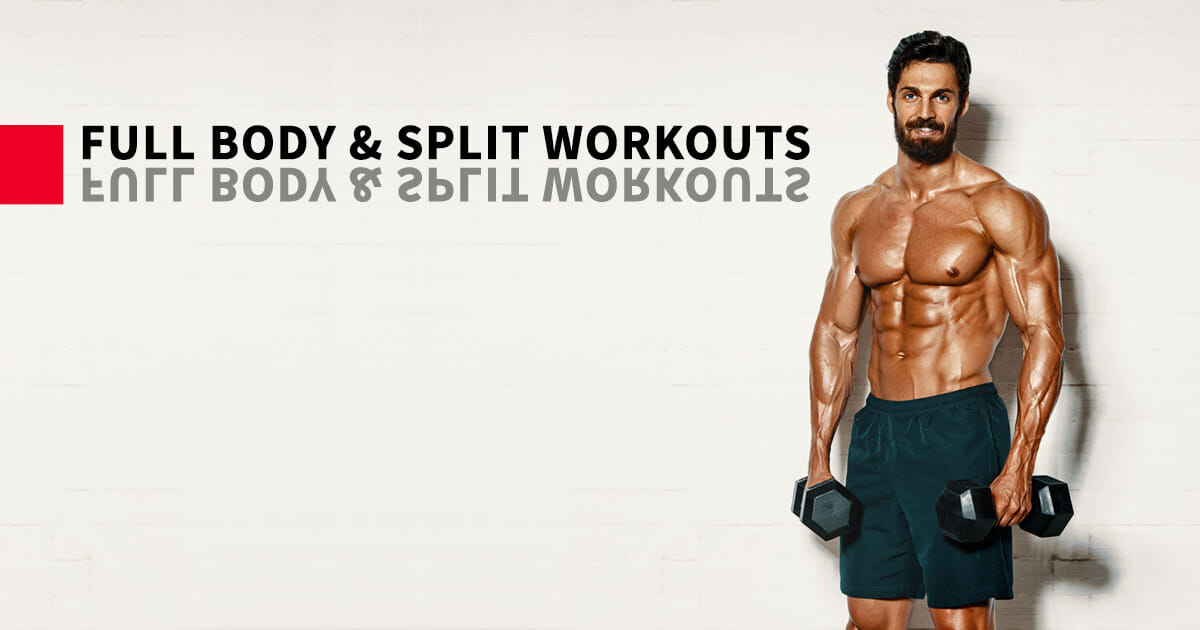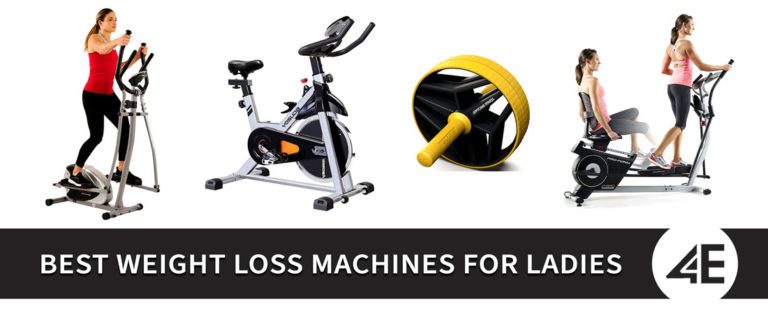Which exercise is better, full-body workouts, or split workouts? And which workout routine is more suitable for you and for achieving your goals. So, let’s get right into it.
Even though some of these concepts may apply to weightlifting, to be aware that the information that I’m going to share is mostly applicable to bodyweight training. With that out of the way, we’re going to be covering,
- Difference between these two methods of training.
- Different approaches for each workout methods.
- Benefits of each workout training.
With these, you can decide which workout training method is the right approach for your own specific goals. So, let’s begin.
Difference between full-body & split training workouts
A full-body training method is exactly that, training each body part from your upper body all the way to your lower body in every workout session of the week. A split training method works by separating your session between either muscle groups, like chest back and legs, or movement partners like push-pull and legs. There are many ways to approach and divide both your full-body workouts as well as your split training.
Full-body Workout Methods
So, let’s begin with the three approaches that you can use when training in a full-body fashion
#1 Full-body Method – 3x sessions per week

The first approach is training three times per week. This method is great for those who only have a limited amount of days to train in a given week. For this method, I will recommend training with a high volume and a high intensity and with at least one day of rest in between each session to get the best possible results.
#2 Full-body Method – 5-6x sessions per week
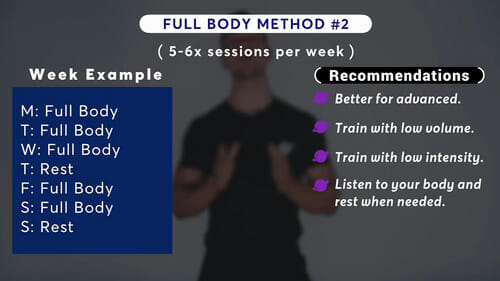
The second approach is to train five to six times per week. This is more suitable for more advanced athletes however beginners can also do it as long as they are not doing more than what their body can handle. This brings me to the recommendation for this method and that applies both to beginners and advanced individuals and those are to keep the volume and intensity low. So, you’re able to train every single day without compromising your recovery.
Now, how much you do and how intense you train is going to depend on your specific fitness level. Listen to your body and if you find yourself not being able to work out the next day that is a clear sign that you overdid it and you need to scale it down, whether that is doing less volume or less intensity.
#3 Full-body Method – 3x sessions + practice per week
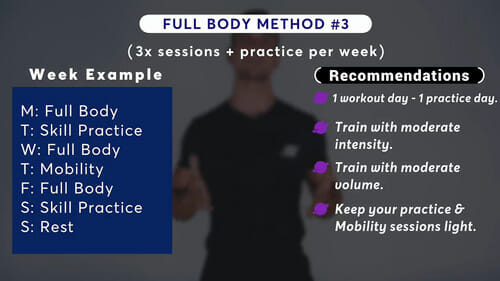
The last approach is probably my favorite when it comes to full body workouts and that is to Train full body three times per week as the first method and instead of resting the following days of your workouts, what you would do is a skill practice or a light mobility session.
For this method, I would recommend to keep the volume and intensity moderate and to keep your practice and mobility sessions very light. Again, the volume and intensity of each are going to depend on your level and recovery capacity.
Split-body Workout Methods
Moving on to split training. There are so many ways to divide your split training. What I’m going to be talking about the three most common ways to approach your skill training.
#1 Split Training Method – Split by muscle groups
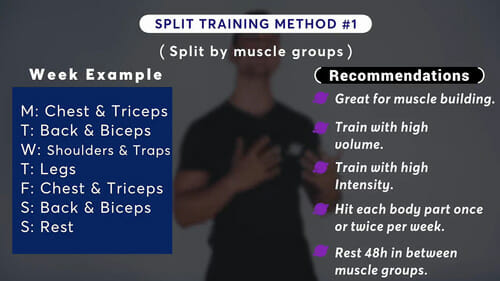
The first method is the one most people are familiar with and that is divided your training into muscle groups. This method works very well if your main goal is to build muscle. There are many ways to leave out your muscle groups but I recommend this.
4-day body parts workout routine
- Day one – chest and triceps.
- Day two – back and biceps.
- Day three – shoulders and traps.
- Day four – legs.
- And then you repeat the cycle.
This is only one way of doing it there are thousands of combinations to choose from.
But whichever way you choose to divide your muscle groups, I recommend to keep a high volume and intensity in each workout as well as making sure you are healing each body part at least once per week and ideally twice per week but that will depend again on your split. If you need four to five days to train all your muscles, I would then repeat whichever muscle group you want to develop the most.
The one or two days that you have left due to the high volume on this type of a split, make sure you are resting your muscles at least 48 hours before you work them out again. However, since we’re talking about bodyweight training it is very hard and sometimes almost impossible to completely isolate a single muscle group.
#2 Split Training Method – Split by movement patterns
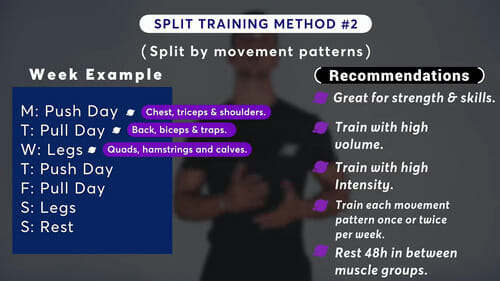
Since most of the exercises are compound exercises so, that is why the second method is a bit more suitable for calisthenics in my own opinion. The split of pull-push and legs, this method works very well if you’re working towards overall strength and even towards the skills.
4-day push-pull workout routine
- Day one – All your pushing movement patterns.
- Day two – All your pull up moves.
- Day three – Do the legs.
- Day Four – Rest.
- And repeat the cycle.
In this method, you could say it is the same as the above since you will be targeting chest, triceps, and shoulder. On your push day back, biceps and traps. On your pull day and then your legs but the key difference is that you will be focusing more on movements rather than muscles.
All the recommendations for the previous method apply to this one as well.
#3 Split Training Method – Split by bent & straight arm/legs
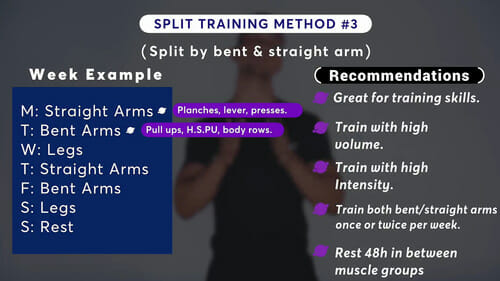
The next approach is also very common in calisthenics and that is to split burn arm a straight arm and legs. This method is a bit more suitable for those focusing more on skills. For this approach, you would do –
- Straight arms at day one.
- Bent arms on day two.
- Legs on day three.
All your swearing-based exercises like clenches and liver progressions. Then the next day, your bent arm-based exercises like pull-ups dip and handstand push-ups, and finally legs. Again, all the recommendations from the previous methods apply to this one as well.
Those are some of the methods that you could use but there are so many combinations to choose from that it would take me thousands of articles to explain each one of them in detail.
At the end of this, I’m going to leave you with my combination that I currently use but before we do that let’s briefly touch on some of the benefits of full-body workouts and split workouts.
Full body training benefits

I’m going to begin by saying that I don’t believe either to be superior to the other one and that the best approach for you is going to depend on so many factors from your current goals, your current level, your previous weeks of training, your previous month and even years of training and so many other things.
So, take this as a simple guide to make your own decisions. With that being said here are some of the benefits of full-body workouts.
Convenient on a tight schedule
First, it is convenient by being able to not train as often and still maximize your results.
Greater energy expenditure
Second, it has greater energy expenditure per workout which leads to a better hormonal balance and rapid fat loss.
Overall health & well-being
Lastly, I just believe full-body workout is better for overall health and well-being since we are designed to move as a unit and not as individual parts.
Split training benefits

However, split training has also some benefits if done right.
Higher volume = more muscle growth
First, is the ability to train with a higher volume per body part which will lead to more muscle growth. That is why a split workout is still used today by most bodybuilders.
Versatility in your training structure
The second benefit is having the freedom of your workouts however you like and therefore being able to prioritize your goals a little bit better.
Less strain on your CNS
Split training allows for a better recovery of your central nervous system. Since you’re only working a portion of your body per day.
Final thoughts

So, which one is better and the answer is that it truly depends, and the three best advice that I can give you are –
Less thinking, more action.
First, don’t get stuck into the rabbit hole of thinking which method is better and losing time and energy into actually putting the work.
Second, is to be very clear about your goals.
And, lastly is to have variety in your training. Try both methods, try the different approaches after body training and the different combination of split training. Watch mindfully how your body reacts and respond to each and do what works for your current circumstances.
Because there will be another point you don't and you shouldn't stick to one specific method of training.
Our body adapts very quickly to any stimulus we give to it and when it comes to getting the most out of your workout’s variety is key.
There will be prioritization which means rotating your training over time but I will leave that for an entirely different theory. Finally, as I said I’m going to tell you my current split so you can see that there is no single golden method that is going to get you towards your goals but that you can be creative and adapt your training to your own needs.
My daily split training
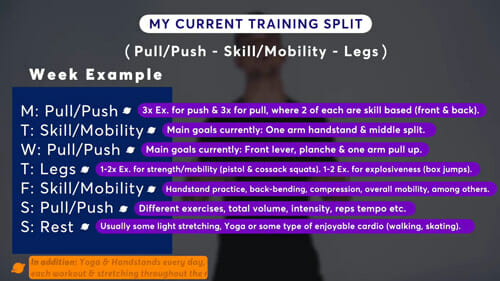
My current split, in summary, is pull-push combined in one session where I do both a straight arm and bent arm exercises as well as both skills and strength-based exercises.
Day two – I do practice or mobility work.
Day three – I go back to pull-push with different exercises total volume and intensity than the previous workouts
Day four – I do legs then. I would either rest one day and repeat or keep going with that order until I feel that my body needs a rest day.
Where I usually do some yoga or some type of cardiovascular activity.
I do full-body workouts and all these approaches. I’ve done hundreds of different esplanades methods. I’ve combined full-body workouts and athlete workouts in one single session and the reality is that all of them work if you know what you are doing and why you are doing it and that is exactly my mission with Saturno movement and that is to give you guys the information.

Daniel Amankwah is a fitness expert for 4EvaFit Lifestyle, personal fitness coach, personal trainer, blogger, and a motivational speaker living in Acton, Massachusetts. His affection for a healthy lifestyle has penetrated through the noise in the health, fitness industry and empowers people to create sustainable prescriptions for lasting health, happiness, and confidence.
A background as a business researcher coupled with a personal passion for fitness help brings our readership a thoughtful curation fitness guide and fitness product review. His burning desire is to share his fitness experience and offer some encouragement to anyone that is working to better themselves physically through healthy eating habits and being active.
As a visionary, his vision is a world where daily acts of self-love and care are a regular part of life.

